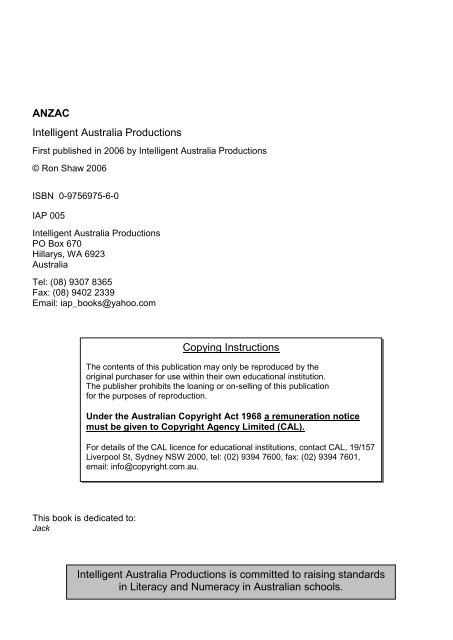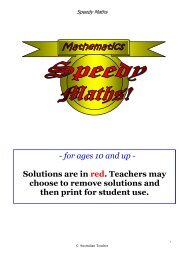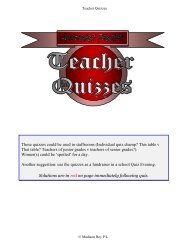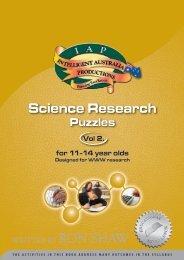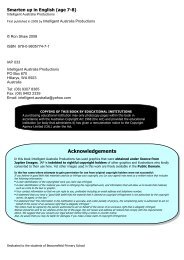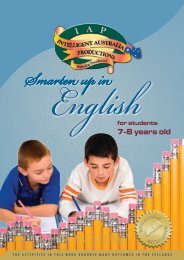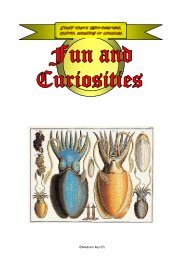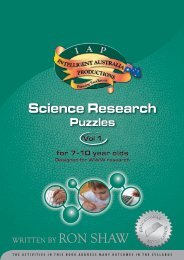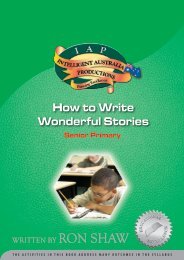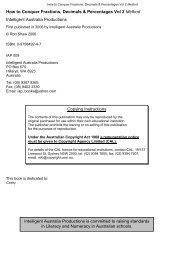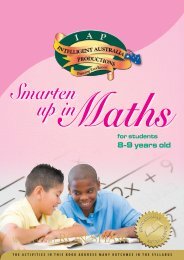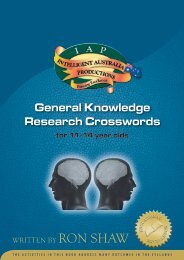ANZAC Intelligent Australia Productions Copying Instructions ...
ANZAC Intelligent Australia Productions Copying Instructions ...
ANZAC Intelligent Australia Productions Copying Instructions ...
- No tags were found...
Create successful ePaper yourself
Turn your PDF publications into a flip-book with our unique Google optimized e-Paper software.
Teachers Notes 3In the Heat of Battle 4Hidden <strong>ANZAC</strong> Words 5Simpson and his Donkey 6The <strong>ANZAC</strong> Poppy 7<strong>ANZAC</strong> Remembrance Shield 8Long Journey 9From Ship to Shore 10<strong>ANZAC</strong> Quiz 11<strong>ANZAC</strong> Meanings 12<strong>ANZAC</strong> Day Award 13<strong>ANZAC</strong> Debate 14<strong>ANZAC</strong> Biscuits 15Peace and Prosperity 16Foes, now Friends 17Thoughts on <strong>ANZAC</strong> Day 18Mateship 19<strong>ANZAC</strong> Crossword 20Loss of a Mate 21In the Trenches 22<strong>ANZAC</strong> Letter 23Bugle Calls 24<strong>Australia</strong> at War 25<strong>ANZAC</strong> Wreath 26The Unknown Soldier 27<strong>ANZAC</strong> Stamps 28Thoughts on <strong>ANZAC</strong> Day 29<strong>ANZAC</strong> Day Announcement 30Missing Kit Bag 31No More Wars 32<strong>ANZAC</strong> Day Poster 33Recognition from King George 34<strong>ANZAC</strong> Words 35Trans-Tasman Cousins 36World Peace Treaty 37<strong>ANZAC</strong> Thoughts 38Students for Peace and Goodwill 39Answers 40Talented Writers 42© <strong>Intelligent</strong> <strong>Australia</strong> <strong>Productions</strong> 2
There is no right or wrong way to use this book; teachers may feel free to use it with their classes inwhichever way they wish.However a few pointers are worth considering.For each page, begin with a class discussion. Discuss the topic. What is required of the students? What should fast finishers do?Some hints on making your work ‘special’. Attend to neatness and obey conventions of good grammar, punctuation and spelling. Be original in your thinking, written responses and illustrations. While completing the activities be conscious of the <strong>ANZAC</strong>s’ contribution to our nation; do them proudby doing your very best work.Displaying your work. Many of the activities in this book lend themselves to display.Attractive displays on classroom walls, display boards, or even in school foyers can be mounted by selectingstudents’ work from this book……a fitting tribute to the <strong>ANZAC</strong>s.Something to Consider. Your local branch of the RSL (<strong>Australia</strong>) and RSA (New Zealand) may well be interested in displayingyour students’ work for members to see. Their telephone number should not be difficult to find or, ifyou prefer, you could write to them with this idea.Your local shopping centre may also be interested in displaying your students’ work.Appeciation.By using this book you and your students are helping to keep the <strong>ANZAC</strong> spirit alive.We thank you sincerely for that.The Editors,IAPAbout Students for Peace and Goodwill (page 39)What can we do to preserve peace where it exists? How can we help to facilitate peace in strife-torn places?How can we lessen distrust between peoples of different races and creeds?One of the very best ways is to spread goodwill.This may be done by presenting (sending) students’ artwork and/or peace messages to the elderly (retirement villages), people inhospitals, or our nation’s leaders. The children’s work may then be displayed for all to see.IAP is happy to distribute batches of your students’ work to such institutions, and political leaders, in countries far distant fromours, particularly those with different races and creeds from our own.We suggest sketches of happy scenes, perhaps containing fauna and/or flora native to our two countries (<strong>Australia</strong> and NewZealand), or other national icons.A message of peace may be included instead of, or as well as, the illustration.The title of the piece goes on the dotted line at the top while the child’s name, age and town are recorded at the bottom, asshown below. For work sent to IAP for overseas distribution add your county name after the town…..By Catherine Age 11Toowoomba, <strong>Australia</strong>Some teachers may prefer to display their students’ work within their classroom or school and this is fine too.Students for Peace and Goodwill is an initiative of IAP© <strong>Intelligent</strong> <strong>Australia</strong> <strong>Productions</strong> 3
Name: ……………………………………………………………………………………..… Class: ………………… Date: ……………….……………………This picture shows the <strong>ANZAC</strong>s at war.Imagine you are one of the soldiers. What thoughts would be going through your mind?When you have finished writing colour in the picture.(Prompts: country, mates, family, survival)…………………………………………………………………………………………………………………………………………………………………...………………………………………………………………………………………………………………………………………………………………………………...………………………………………………………………………………………………………………………………………………………………………………...………………………………………………………………………………………………………………………………………………………………………………...………………………………………………………………………………………………………………………………………………………………………………...………………………………………………………………………………………………………………………………………………………………………………...………………………………………………………………………………………………………………………………………………………………………………...………………………………………………………………………………………………………………………………………………………………………………...………………………………………………………………………………………………………………………………………………………………………………...………………………………………………………………………………………………………………………………………………………………………………...………………………………………………………………………………………………………………………………………………………………………………...………………………………………………………………………………………………………………………………………………………………………………...………………………………………………………………………………………………………………………………………………………………………………...………………………………………………………………………………………………………………………………………………………………………………...……………© <strong>Intelligent</strong> <strong>Australia</strong> <strong>Productions</strong> 4
Name: ……………………………………………………………………..… Class: ………………… Date: ……………………………………..….………………E A N Z S A A Z N A R E G G I D A DD U W B T B N N N U R S R U N A N IT S A U U R R Z T U R T I U K U Z GG S R R A G E A A U U L R I I S D SY B Z G U G L P T C O R W G W T I RH O T G G G E E Z P U D M A A R I UB R Z I I A O S I N I E E L K A D NW E D D C R D L E E D A D L N L L RF H D E P L L E L S P E A I U I O AG L M I O A M F B D R P L P R A S MR A T S G E I M E E L U I L L A G EE R U E R R M E V I A O N E A P F DB T R M H I A D A S R G S P P P L P AM S K E C D R E R S U A R B A Z A AE U S R R L C M B U T I L L I R N DM A U E A O U A W A L F F G O W R EE T H W M S B R E I D L O S O S I MR M A R A M A R F L A G Z N A L F K <strong>ANZAC</strong> GALLIPOLI MEDAL HERO SOLDIERMARCH APRIL AUSTRALIA REMEMBERAUSSIE KIWI BRAVE WAR PEACE DIGGERTURKS FLAG NURSES BUGLE RIFLE© <strong>Intelligent</strong> <strong>Australia</strong> <strong>Productions</strong> 5
Name: ……………………………………………………………………………….…… Class: ………………… Date: ……….…………………..……………Somehow the wounded soldiers had to be taken to the field hospitals at <strong>ANZAC</strong> Cove – this was thejob of the stretcher bearers. A stretcher bearer named John Simpson used a donkey to help himcarry the wounded men back to safety.Week after week, Simpson and his donkey, Duffy, braved the Turkish bombs and bullets to rescuewounded <strong>ANZAC</strong>s scattered amongst the steep and rocky hills of Gallipoli.Do you think Simpson looked upon Duffy as a beast of burden or afriend? Give reasons for your answer.……………………………………………………………….…………………………………………..…..……………………………………………………………………….………………………………………..….………………………………………………………………………….……………………………………..….…………………………………………………………………………..…………………………………….….……………………………………………………………………………….…………………………………….……………………………………………………………………………….……………………………….…………………………………………………………………………………….…………………………….……Simpson and his donkey appear on the <strong>ANZAC</strong> Medal which was awarded to every <strong>ANZAC</strong> soldier……………………………………………………………………………………………………who served on the Gallipoli Peninsula.Perhaps you think it is not right to give this donkey such a prominent place in <strong>ANZAC</strong> history………after allit is only an animal. Maybe a soldier and a nurse should be on the <strong>ANZAC</strong> medal. What are your thoughts?……………………………………………………………………………………………………………………………………………………………………………….………………………………………………………………………………………………………………………………………………………………………………….………………………………………………………………………………………………………………………………………………………………………………….………………………………………………………………………………………………………………………………………………………………………………….………………………………………………………………………………………………………………………………………………………………………………….………………………………………………………………………………………………………………………………………………………………………………….………………………………………………………………………………………………………………………………………………………………………………….………………………………………………………………………………………………………………………………………………………………………………….………………………………………………………………………………………………………………………………………………………………………………….………………………………………………………………………………………………………………………………………………………………………………….…© <strong>Intelligent</strong> <strong>Australia</strong> <strong>Productions</strong> 6
The <strong>ANZAC</strong> PoppyThe poppy has long been associated with WW1 - for the poppies that grew inFlanders. The poet John McCrae wrote this poem in 1915:In Flanders FieldsIn Flanders Fields the poppies blowBetween the crosses, row on row,That mark our place; and in the skyThe larks, still bravely singing flyScarce heard amid the guns below.We are the Dead. Short days agoWe lived, felt dawn, saw sunset glow,Loved, and were loved, and new we lieIn Flanders FieldsTake up our quarrel with the foe;To you from failing hands we throwThe torch; be yours to hold it high.We shall not sleep, though poppies growIn Flanders FieldsBlooming brilliant orange with 5 cm blossoms in early spring, the flowers become straw-coloured andsmaller as summer approaches. After the four petals unroll the bright blossoms open in the sunshine,painting fields and hillsides golden orange. The seed capsules are long and pointed, and as they dry, theytwist open with a pop that sends the round black seeds flying.Sketch a field showing a brilliant array of poppies.Perhaps you could also show the graves of some brave <strong>ANZAC</strong>s.© <strong>Intelligent</strong> <strong>Australia</strong> <strong>Productions</strong> 7
Colour the shield then draw your own <strong>ANZAC</strong> sketches around it(eg poppies, soldiers, Simpson & his donkey, VC medal etc)© <strong>Intelligent</strong> <strong>Australia</strong> <strong>Productions</strong> 8
Help our Digger home.It’s 1918 and the war is over.There is more than one way to get home. Find the shortest wayand see how far it is from Gallipoli to <strong>Australia</strong>.1 cm = 650 km approx’.Which one of these is your answer close to?1560 km 15 600 km 156 000 kmTell about the Digger’s thoughts as he heads for home.…………………………………………………………………………………………………………………………………………...………………….…………………………………………………………………………………………………………………..…………………..…………………….……………………………………………………………………………………………………………………………………..……………………….…………………………………………………………………………………………………………………..…………………..…………………….……………………………………………………………………………………………………………………………………..……………………….…………………………………………………………………………………………………………………..…………………..…………………….What might be some questions hisfamily and friends could ask?…………………………………..………………………….………...………...……………………………………………………....…………………………………………………….....……………….…………………………………………………..…...……………………………………………………………...…..………………......………………………...…..………………………….………………..………© <strong>Intelligent</strong> <strong>Australia</strong> <strong>Productions</strong> 9
Above is a well-known painting of the troops’ arrival at <strong>ANZAC</strong> Cove.Describe the scene.…………………………………………………………………………………………………………………………………………………………………………………………………………………………………………………………………………………………………………………………………………..…………………………………………………………………………………………………………………………….…………………………………………………………….………………………………………………………………………………………………………………………………………………………………………………………………………………………………………………………………………………………………………………………………………………………………………..………………………………………………………………………………………………………………………………….……………………………………………………….………………………………………………………………………………………………………………………………………………………………………………………………………………………………………………………………………………………………………………………………………………………………………..…………………………………………………………………………………………………………………………….…………………………………………………………….………………………………………………………………………………………………………………………………………………………………………………………………………………………………………………………………………………………………………………………………………………………………………..………………………………………………………………………………………………………………………………….……………………………………………………….………………………………………………………………………………………………………………………………………………………………………………………………………………………………………………………………………………………………………………………………………………………………………..…………………………………………………………………………………………………………………………….…………………………………………………………….……………………………………………………………………………………………………………………………………………………………………………………………………………………© <strong>Intelligent</strong> <strong>Australia</strong> <strong>Productions</strong> 10…………………………………………………………………………………………………………………………………………………..…………………………………
1. Which soldiers were called Kiwis? ……………………………………………………………………………….………2. What is another name for troops? ……………………………………………………………………….…3. Were the <strong>ANZAC</strong>s part of the Allies? …………………………………………………………………………………………………..4. Against which nation did the <strong>ANZAC</strong>s fight at Gallipoli ? ……………………………………………………………………….5. <strong>ANZAC</strong> stands for ……………………………………………………………………………………………………………..........……………………..6. In what year did the troops land at <strong>ANZAC</strong> Cove? ……………………..………….7. How many stars on the flag of <strong>Australia</strong>? …………………………………..8. What is a Digger? …………………………………………………………………………………………………………….……………..9. What brightly coloured flower grew in the fields of Flanders? ………………………………………..……………………10. What do the initials VC stand for? ………………………………………………………………………………..………………………..…11. Between which years was World War 1 fought? ……………………………………………………………………………………12. Were any of the <strong>ANZAC</strong>s women? ……………………………………………………………………13. What does enlist mean? …………………………………………………………………………………………………………………………….14. Which <strong>ANZAC</strong> soldier was assisted by a donkey? ……………………………………….…………………………………………15. How many stars on the flag of New Zealand? ……………………..………………16. What do the letters RIP stand for? ………………………………………………………………………………………………………….17. From what common word does memorial come? ………………………………………………………………………………….18. Describe the flag of Turkey ………………………………………………………….…………………………………………..…………………19. Which war was <strong>Australia</strong> involved in before WW1? ……………….…………………………………………………...…………20. Which bugle call is played at military funerals? …………………………………………………………………………..…………Finished the Quiz?Colour the maps and mark inoceans and seas © <strong>Intelligent</strong> <strong>Australia</strong> <strong>Productions</strong> 11
Make sentences from these <strong>ANZAC</strong> words.Use interesting words (well-chosen adjectives, verbs and adverbs) to enrich your writing.AlliesVictoria CrossbattalionambushpoppyKiwi<strong>ANZAC</strong> CovetrenchescobbervalourcommemorateDiggerenlist© <strong>Intelligent</strong> <strong>Australia</strong> <strong>Productions</strong> 12
© <strong>Intelligent</strong> <strong>Australia</strong> <strong>Productions</strong> 13
‘It is important in <strong>Australia</strong> to spendmore money on Defence than on Education’.Write arguments either supporting or disagreeing with this.……………………………………………………………………………………………………………………………………………………………..……………………………………………………………………………………………………………………………………………………………..……………………………………………………………………………………………………………………………………………………………..……………………………………………………………………………………………………………………………………………………………..……………………………………………………………………………………………………………………………………………………………..……………………………………………………………………………………………………………………………………………………………..……………………………………………………………………………………………………………………………………………………………..……………………………………………………………………………………………………………………………………………………………..……………………………………………………………………………………………………………………………………………………………..……………………………………………………………………………………………………………………………………………………………..……………………………………………………………………………………………………………………………………………………………..……………………………………………………………………………………………………………………………………………………………..……………………………………………………………………………………………………………………………………………………………..……………………………………………………………………………………………………………………………………………………………..……………………………………………………………………………………………………………………………………………………………..……………………………………………………………………………………………………………………………………………………………..© <strong>Intelligent</strong> <strong>Australia</strong> <strong>Productions</strong> 14
During World War 1, the wives, mothers and girlfriends of the <strong>Australia</strong>n soldiers were concerned about the nutritionalvalue of the food being supplied to their men. There was a problem. Any food they sent to the fighting men had to becarried in the ships of the Merchant Navy. Most of these were lucky to maintain a speed of ten knots (18.5 kilometresper hour). Most had no refrigerated facilities, so any food sent had to be able to remain edible for periods in excess oftwo months. A group of women came up with the answer - a biscuit with all the nutritional value possible. The basis wasa Scottish recipe using rolled oats. These oats were used extensively in Scotland, especially for a heavy porridge thathelped counteract the extremely cold climate.The ingredients they used were: rolled oats, sugar, plain flour, coconut, butter, golden syrup or treacle, bicarbonate ofsoda and boiling water. All these items did not readily spoil. At first the biscuits were called Soldiers’ Biscuits, but afterthe landing on Gallipoli, they were renamed <strong>ANZAC</strong> Biscuits.A point of interest is the lack of eggs to bind the <strong>ANZAC</strong> biscuit mixture together. Because of the war, many of thepoultry farmers had joined the services, thus eggs were scarce. The binding agent for the biscuits was golden syrup ortreacle. Eggs that were sent long distances were coated with a product called ke peg (like Vaseline) then packed inairtight containers filled with sand to cushion the eggs and keep out the air.As the war drew on, many groups like the CWA (Country Women’s Association), church groups, schools and otherwomen’s organisations devoted a great deal of time to the making of <strong>ANZAC</strong> biscuits. To ensure that the biscuitsremained crisp, they were packed in used tins, such as Billy Tea tins. You can see some of these tins appearing in yoursupermarket as exact replicas of the ones of earlier years. Look around. The tins were airtight, thus no moisture in theair was able to soak into the biscuits and make them soft. Most people would agree there is nothing worse than a softbiscuit.During World War 2, with refrigeration in so many Merchant Navy Ships, the biscuits were not made to any great extent.It was now possible to send a greater variety of food, like fruit cake.<strong>ANZAC</strong> biscuits are still made today. They can also be purchased from supermarkets and specialty biscuit shops. Around<strong>ANZAC</strong> Day, these biscuits are also often used by veterans’ organisations to raise funds for the care and welfare of agedwar veterans.- Cut out or copy -Anzac Biscuits RecipeMelt & Mix MethodIngredients: 125gm Butter 2 tablespoons Golden Syrup 1 Cup Coconut 2 teaspoons Bicarbonate Soda 1 Cup Flour 1 Cup Sugar 1 Cup Rolled Oats 2 tablespoons Boiling WaterMethod:1. Melt butter and Golden Syrup.2. Dissolve soda in boiling water.3. Add liquids to dry ingredients.4. Place in teaspoon-size lumps on agreased baking tray5. Bake at 160 degrees Celcius for 18 -20 mins.6. Cool on cake cooler.SketchIn this space draw a picture of some<strong>ANZAC</strong>s enjoying a snack of <strong>ANZAC</strong>biscuits with a cup of tea.Writing ActivityOn a separate piece of paper or in your bookwrite a summary of the passage at the top (120-200 words).© <strong>Intelligent</strong> <strong>Australia</strong> <strong>Productions</strong> 15
The <strong>ANZAC</strong>s fought a battle to protect our nation.Here are some things I can do to make <strong>Australia</strong> a better place.(fill in and then lightly colour)Maybe pool ideas with classmates and then display them.© <strong>Intelligent</strong> <strong>Australia</strong> <strong>Productions</strong> 16
ResearchName: …………………………………………………………………..….………..… Class: ………………… Date: ……………..…….………….……………These days there are many Turks living in <strong>Australia</strong>.Our two nations get along very well….unlike in 1915.How must the Turks have felt when our heavily armed soldiersstormed onto a beach in their homeland?What if Turkish soldiers had come to <strong>Australia</strong> and landed on an <strong>Australia</strong>n beach?Wouldn’t we have defended our shores as vigorously as they did?We know that our soldiers were very brave….but so were the Turks.Turkey is a nation with a fascinating, rich history and in parts it is very beautiful.However the country has been devastated by some terrible earthquakes.<strong>Australia</strong> and Turkey have many differences.See what you can find out about Turkey before completing the table below.hemispherecontinentpopulationmain languagemain religioncurrencyflag colourcapital citymain industriesnatural disasters<strong>Australia</strong>Turkey© <strong>Intelligent</strong> <strong>Australia</strong> <strong>Productions</strong> 17
In the space belowwrite a poem or short story called‘The Genie who brought World Peace.’© <strong>Intelligent</strong> <strong>Australia</strong> <strong>Productions</strong> 18
It is thought that the famous <strong>Australia</strong>n ‘mateship’ had its origins at Gallipoli where soldiers foughtalongside one another with courage and sacrifice.David Kalmund, a big, rough ‘Aussie’ from Victoria, said this when asked what a mate is.I don’t use the word ‘mate’ lightly.A mate is one who is prepared to make the ultimate sacrifice for his mate…..yep, die.I think the word might have been coined in Gallipoli somewhere between 1914 and 1918.Mates can say and do nothing to offend each other. You stick together through thick and thin.You cry together, fight together, drink together - whatever it takes! You defend them to all corners andgive them yourself, not a facade!!You are never scared when you are with a mate because he or she feels what you feel - you are one!You don't need to live in each other's pocket to be mates. I have mates who live miles from me but if Iget into trouble just try and stop them from coming to help. And me for them. Describe what could be happening in this picture.…………………………………………………………………….…………………………………..……………………………………….…………………………………………………………………….…………………………………..……………………………………….…………………………………………………………………….…………………………………..……………………………………….……………………………………………………………………….…………………………………..………………………………………………………………………………………………………….…………………………………..……………………………………….…………………………………………………………………….…………………………………..……………………………………….Think about one of your closest friends.What makes him or her such a good mate?……………………………………………………………………………………………………………………………………………………………………………………………………………………………………………………………………………………………………………………………………………………………………………………………………………………………………………………………………………………………………………………………………………………………………………………………………………………………………………………………………………………………………………………………………………………………………………………………………………………………………………………………………………………………………………………………………………………………………………………………………………………………………………………………………………………………………………………………………………………………………………………………………………………………………………………………………………………………………………………………………………………………………………………………………………………………………………………………………………………………………………………………………………………………………………………………………………………………………………………………………………………………………………………………………………………………………………………………………………………………………………………………………………………………………………………………………………………………………………………………………………………………………………………………………………………………………………………………………………………………………………………………………………………………………………………………………………………………………………………………………………………………………………………………………………………………© <strong>Intelligent</strong> <strong>Australia</strong> <strong>Productions</strong> 19
Clues Downd1 Another wordfor friend.f1 His (Her)Majesty’s <strong>Australia</strong>nShip abbrevk1Aussie soldier.a2 Where the<strong>ANZAC</strong>s fought.i2 Rifle withsword at end.c5 Animal thathelped carrywounded <strong>ANZAC</strong>s.f6 NewZealander.m6 They fought atGallipoli.h9 The <strong>ANZAC</strong>sfought them atGallipoli.j9 When someenlisted as soldiersthey were merely_ _ _ _.e11 Sometimesthe unwashed facesof the soldiers werecovered in_ _ _ _.1234567891011121314a b c d e f g h i j k l m nClues Acrossa3 Home of vegemite, kangaroos and Diggers.k3 Rifles and pistols are _ _ _ _.a5 The wounded soldier was just a _ _ _.h5 The battle took place at <strong>ANZAC</strong> _ _ _ _.k6 So that they couldn’t be seen they attackedfrom the _ _ _ _.e7 Gun with a long bore.c9 Sign up.l10 Victoria Cross initialsg11 Air Force, Navy, _ _ _ _.j12 How a Private addresses a Major.c13 These service women played a vital role inWW1.© <strong>Intelligent</strong> <strong>Australia</strong> <strong>Productions</strong> 20
What might the soldier be thinking?Write your answer as a poem if you wish.(enhance your work by designing an attractive border around the edges)……………………………………………………………………………………………………………………………………...………………………………………………………………………………………………………………………………………………………………………………...………………………………………………………………………………………………………………………………………………………………………………...………………………………………………………………………………………………………………………………………………………………………………...………………………………………………………………………………………………………………………………………………………………………………...………………………………………………………………………………………………………………………………………………………………………………...………………………………………………………………………………………………………………………………………………………………………………...………………………………………………………………………………………………………………………………………………………………………………...………………………………………………………………………………………………………………………………………………………………………………...………………………………………………………………………………………………………………………………………………………………………………...………………………………………………………………………………………………………………………………………………………………………………...………………………………………………………………………………………………………………………………………………………………………………...………………………………………………………………………………………………………………………………………………………………………………...………………………………………………………………………………………………………………………………………………………………………………...………………………………………………………………………………………………………………………………………………………………………………...………………………………………………………………………………………………………………………………………………………………………………...…………………………………………© <strong>Intelligent</strong> <strong>Australia</strong> <strong>Productions</strong> 21
These soldiers are posing for a photograph butwhat must it have been like in the heat of battle?describe the sights.Hints: dirt, flashes, mates, wounds etc……………………………………………………………………………………………………………….……………………………………………………………………………………………………………………………………………………………………………….……………………………………………………………………………………………………………………………………………………………………………….……………………………………………………………………………………………………………………………………………………………………………….……………………………………………………………………………………………………………………………………………………………………………….………………………………………………………………describe the sounds.Hints: chatter, walkie-talkie, explosions, screams etc……………………………………………………………………………………………………………….……………………………………………………………………………………………………………………………………………………………………………….……………………………………………………………………………………………………………………………………………………………………………….……………………………………………………………………………………………………………………………………………………………………………….……………………………………………………………………………………………………………………………………………………………………………….………………………………………………………………describe the smellsHints: gunpowder, boot leather, perspiration etc……………………………………………………………………………………………………………….……………………………………………………………………………………………………………………………………………………………………………….……………………………………………………………………………………………………………………………………………………………………………….……………………………………………………………………………………………………………………………………………………………………………….……………………………………………………………………………………………………………………………………………………………………………….……………………………………………………………………………………………………………………………………………………………………………….………………………………………………………………© <strong>Intelligent</strong> <strong>Australia</strong> <strong>Productions</strong> 22
It’s 1915 and the world is at war. Back in <strong>Australia</strong> a young womanwaits anxiously for her fiancé to return from Gallipoli.Inside the ring either pretend you are the soldier and write an extract from oneof your letters to your bride-to-beor pretend you are the young lady and writean extract from one of your letters to your brave <strong>ANZAC</strong>.Your aim in this extract is to bring your partner up to date with local events.© <strong>Intelligent</strong> <strong>Australia</strong> <strong>Productions</strong> 23
Throughout the Army's history the sound of the bugle has called soldiers to battle, to roll call,to meals and, in the end, to a well deserved rest when the war is over.Military bugle calls awaken sleepy soldiers, announce meal time and proclaim the day's end. Thesedays bugle calls are sometimes played on tape but people will always prefer and enjoy the playing ofa live bugler. Regardless of how the bugle calls are played they are still treated with the honour,respect and the attention they deserve.Last PostIn military tradition, the Last Post is the bugle call that signifies the end of the day's activities.It is also sounded at military funerals and commemorative services such as Anzac Day andRemembrance Day to indicate that the soldier has gone to his final rest.Write an acrostic poem about the bugle and then sketch a bugle next to your poem.B………………………………………………………………………………………………………………………………………………….U………………………………………………………………………………………………………………………………………………….G………………………………………………………………………………………………………………………………………………….L………………………………………………………………………………………………………………………………………………….E………………………………………………………………………………………………………………………………………………….© <strong>Intelligent</strong> <strong>Australia</strong> <strong>Productions</strong> 24
Here are some major wars in which <strong>Australia</strong> has been involved.Write a few words about them giving the years between which they were fought.Boer War……………………………………..……………………………………………………………………………………………………………………………………..…………………………………………………….……………………….……………………………………………..……………………………………………………………………………………………………………………………………..Word War 1…………………………………………………….……………………….………World War 2…………………………………………………………………………………………………………………………..…………………………………………………………………………………………………………………………………….……………………………………..……………………………………………....…………………………………………………….……………………….…………………………………………………………………………………..…………Vietnam War……………………………………..……………………………………..………..………………………………………………………………………………..………………………………………………………….……………………….………Gulf War………………………………………………………………………………..………………………………………………………………………………….…………………………………………………………….……………………….………© <strong>Intelligent</strong> <strong>Australia</strong> <strong>Productions</strong> 25
How to make anThe two main decorative plants are Rosemary and the Red Poppy.Red PoppyUsually referred to as the Flanders Poppy, the corn poppy signifies the soldiers who sacrificed their livesand their health so that we may live in a country of freedom.The Flanders Poppy is so named because it grew profusely in the trenches and fields of the war zone.It also flowers in Turkey and did so in 1915 when the <strong>ANZAC</strong>s landed at Gallipoli.RosemaryRosemary is the symbol of remembrance.In ancient times Rosemary was said to improve memory and its significance as a symbol of remembrance has carriedthrough the ages. On <strong>ANZAC</strong> day small sprigs of Rosemary are pinned in coat lapels, on the breast pocket of clothingor behind medals as a symbol of remembrance to the <strong>ANZAC</strong>s who gave their lives during war.What you will need to make a WreathOne pre-made 30 -35cm pine or ivy wreath10-12 single silk red poppiesOne bunch fresh rosemaryRibbon or bowLow temperature glue gun or thick craft glueOptional: Laminate a picture of an <strong>ANZAC</strong> soldier to fasten to the wreathMaking the Wreath1. Set the wreath on a surface in front of you. Using the glue gun, cluster 3- 4 poppies atthe top and bottom of the wreath; centered.2. Place the other poppies in various places on the wreath (space them out).3. Using the glue gun, fasten several sprigs of rosemary on each side of the poppies,giving the wreath some height and texture.4. Take the remaining rosemary and attach it at various spots in between the poppies.The fresh rosemary will gradually dry but when it does it will still look fine.5. The wreath does not need to be completely covered……just enough to give it colourand texture.6. The bow can be attached where you desire; either under the poppies or above them.7. If you would like to use a picture of an <strong>ANZAC</strong> soldier you can laminate a copy of aphoto; 7.5cm x 12.5cm or 10cm x 15cm would work well.8. Carefully fasten the picture on the bottom inside of the wreath, tucking and gluing itinto the pine or ivy.Now lay the finished wreath at your school or local <strong>ANZAC</strong> service.© <strong>Intelligent</strong> <strong>Australia</strong> <strong>Productions</strong> 26
Funeral Service of the Unknown <strong>Australia</strong>n SoldierSpeech by the Prime Minister, the Hon P.J. Keating, MPCanberra, 11 November 1993We do not know this <strong>Australia</strong>n's name and we never will. We do not know his rank or his battalion. We do not know where he wasborn, or precisely how and when he died. We do not know where in <strong>Australia</strong> he had made his home or when he left it for thebattlefields of Europe. We do not know his age or his circumstances - whether he was from the city or the bush; what occupation heleft to become a soldier; what religion, if he had a religion; if he was married or single. We do not know who loved him or whom heloved. If he had children we do not know who they are. His family is lost to us as he was lost to them. We will never know who this<strong>Australia</strong>n was.Yet he has always been among those we have honoured. We know that he was one of the 45,000 <strong>Australia</strong>ns who died on the WesternFront. One of the 416,000 <strong>Australia</strong>ns who volunteered for service in the First World War. One of the 324,000 <strong>Australia</strong>ns who servedoverseas in that war, and one of the 60,000 <strong>Australia</strong>ns who died on foreign soil. One of the 100,000 <strong>Australia</strong>ns who have died in warsthis century. He is all of them. And he is one of us.This Unknown <strong>Australia</strong>n is not interred here to glorify war over peace; or to assert a soldier's character above a civilian's; or one raceor one nation or one religion above another; or men above women; or the war in which he fought and died above any other war; or ofone generation above any that has or will come later.The Unknown Soldier honours the memory of all those men and women who laid down their lives for <strong>Australia</strong>. His tomb is a reminderof what we have lost in war and what we have gained.We have lost more than 100,000 lives, and with them all their love of this country and all their hope and energy.We have gained a legend: a story of bravery and sacrifice and with it a deeper faith in ourselves and our democracy, and a deeperunderstanding of what it means to be <strong>Australia</strong>n.It is not too much to hope, therefore, that this Unknown <strong>Australia</strong>n soldier might continue to serve his country - he might enshrine anation's love of peace and remind us that in the sacrifice of the men and women whose names are recorded here there is faith enoughfor all of us.Either write a poem in tribute to the Unknown Soldier orsay how his memory should best serve us.Unknown Soldier…………………………………………………………………………..………………………………………………………………………………………………………………………………..…………………………………………………………………………….………………………………………………………………………………………………………………………………………………………………………………………………………………………………..………………………………………………………………………….…………………………………………………………………………………………………………………………………………………………………………………………………………………………..…………………………………………………………………………..……………………………..…………………………………………………………………………………………………………………………………………………………………………………………………..…………………………………………………………………………..……………………………..© <strong>Intelligent</strong> <strong>Australia</strong> <strong>Productions</strong> 27
Here are some commemorative stamps,each with a War theme.Imagine you have been given the task of coming up with the designsfor two, very different, <strong>Australia</strong>n commemorative <strong>ANZAC</strong> stamps.Show your designs here.© <strong>Intelligent</strong> <strong>Australia</strong> <strong>Productions</strong> 28
Write a story or poem as aHere’s the picture.tribute Write to the <strong>ANZAC</strong>s.poem.(enhance Decorate your with work an with attractive an attractive border. border)……………………………………………………………………………………………………………………………………………………………………………………………………………………………………………………………………………………………………………………………………………………………………………………………………………………………………………………………………………………………………………………………………………………………………………………………………………………………………………………………………………………………………………………………………………………………………………………………………………………………………………………………………………………………….……………………………………………………………………………………………………………………………………………………………………………………………………………………………………………………………………………………………………………………………………………………………………………………………………………………………………………………………………………………………………………………………………………………………………………………………………………………………………………………………………………………………………………………………………………………………………………………………………………………………………………………………………………………………………………………………………………………………………………….……………………………………………………………………………………………………………………………………………………………………………………………………………………………………………………………………………………………….……………………………………………………………………………………………………………………………………………………………………………………………………………………………………………………………………………………………………………………………………………………………………………………………………………………………………………………………………………………………………………………………………………………………………………………………………………………………………………………………………………………………………………………………………………………………………………………………………………………………………………………………………………………………………………………………………………………………………………………………………………………………………………………………………………………….……………………………………………………………………………………………………………………………………………………………………………………….………………………………………………………………………………………………………………………………………………………………………………………………………………………………………………………………………………………………………………………………………………………………………………………………………………………………………………………………………………………………………………………………………………………………………………………………………………………………………………………………………………………………………………………………………………………………………………………………………………………………………………………………………………………………………………………………………………………………………………………………………………………………………………………………………………………………………………………………………………………………………………………………………………………………………………………………………………………………………………………………………© <strong>Intelligent</strong> <strong>Australia</strong> <strong>Productions</strong> 29
For your Class or School to notify parents and community of your special <strong>ANZAC</strong> Day service.© <strong>Intelligent</strong> <strong>Australia</strong> <strong>Productions</strong> 30
A kit bag containing a soldier’s personal belongings was left behind on thewharf at Sydney, just after HMAS <strong>ANZAC</strong> left for Gallipoli.1. In the space below sketch a person who comes across the kit bag (perhaps you could draw some otherpeople in the background). Is there some kind of identifying tag on the kit bag?2. List all the items that might be in the kit bag (spareuniform and boots, civilian clothing, diary, photographs, address book,playing cards, magazines and books, toiletries, radio etc). Any others?……………………………………………………………………..…………………………….………………………………………………………………………………………..…………………………….……………………………………………………………………………………………..………………….…………………………………………………………………………………………..………………….………………………………………………………………………………………………..…………………….…………………………………………………………………………………………..…………………….……………………………………………………………………………………………..…………….…………3. Say what you would do if you were the person who found the soldier’s kit bag.…………………………………………………………………………………………………..………………………………………………………………………………………………………………………………………………………………………………………………………………………………………………………………………………………………………………………………………………………………………………………………………………………………..……………………………………………………………………………………………………………………………………………………………………………………………………………………..……………………………………………………………………………………………………………………………………………………………………………………………………………………..………………………………………………………………………………………………………………………………………………………………………………………………………………………………..……………………………………………………………………………………………………………………………………………………………………………………………………………..………………………4. Imagine you are the soldier. You are sailing away from Sydney and you’ve just realised your kit bag ismissing. You’re hoping very much that somehow you will get it back, with all the items still intact.Say what items mean the most (are the most valuable) to you and what it is about each one that gives it itsvalue. Note: Your spare uniform, boots etc can be replaced by the army if necessary.………………………………………………………………………………………………………………………………………………………………………………………………………………………………………………………………………………………………………………………………………………………………………………………………………………………………..……………………………………………………………………………………………………………………………………………………………………………………………………………………..……………………………………………………………………………………………………………………………………………………………………………………………………………………..………………………………………………………………………………………………………………………………………………………………………………………………………………………………..……………………………………………………………………………………………………………………………………………………………………………………………………………..………………………5. Good news! You’ve just arrived in Europe after the long voyage from <strong>Australia</strong> and you hear that yourmissing kit bag is being sent to you. You have the finder’s address. How will you express your deep gratitudeto him/her?………………………………………………………………………………………………………………………………………………………………………………………………………………………………………………………………………………………………………………………………………………………………………………………………………………………………..……………………………………………………………………………………………………………………………………………………………………………………………………………………..…………………© <strong>Intelligent</strong> <strong>Australia</strong> <strong>Productions</strong> 31
…poppy again was widely noticed after soils in France and Belgium became rich in lime from rubble duringthe First World War. The little red flowers flourished around the graves of the war dead as they had 100years earlier.Next to each point on the 5 pointed star write areason why it would be good if therewere no more wars.Use colours to enhance and decorate your answers.----------------------------------------------------------------------------------------------------------------------------------------------------------------------------------------------------------------------------------------------------------------------------------------------------------------------------------------------------------------------------------------------------------------------------------------------------------------------------------------------------------------------------------------------------------------------------------------------------------------------------------------------------------------------------------------------------------------------------------------------------------------------------------------------------------------------------------------------------------------------------------------------------------------------------------------------------------------------------------------------------------------------------------------------------------------------------------------------------------------------------------------------------------------------------------------------------------------------------------------------------------------------------------------------------------------------------------------------------------------------------------------------------------------------------------------------------------------------------------------------------------© <strong>Intelligent</strong> <strong>Australia</strong> <strong>Productions</strong> 32
Using what you know about <strong>ANZAC</strong> Day, Gallipoli or anything else to do with our braveservicemen and women design your own commemorative poster to honour the <strong>ANZAC</strong>s.Ideas: Simpson and his donkey, the VC badge, Gallipoli scene; perhaps a collage of all of these.Name………………………………………….……………………….……………. Class……………………..…………………..© <strong>Intelligent</strong> <strong>Australia</strong> <strong>Productions</strong> 33
When the <strong>ANZAC</strong>s were doing battle at GallipoliKing George of England reigned over thepowerful British Empire (of which <strong>Australia</strong> andNew Zealand were part).At the bottom of the poster (at left) the Kingsays,“The <strong>Australia</strong>n and New Zealand troops haveindeed proved themselves worthy sons of theEmpire.”What do you think King George meant bythis statement?………………………………………………………………………………………………………………………………………………………………………………………………………………………………………………………………………………………………………………………………………………………………………………………………………………………………………………………………………………………………………………………………………………………………………………………………………………………………………………………………………………………………………………………………………………………………………Now read the following passage and answer the question beneath it.<strong>ANZAC</strong>s help out British Army in Europe…………………………………………………………………….……………Britain went to war in 1914 with a very small but professional army. Up until the War the army’s main job wasto look after the British Empire. Man-for-man, the British soldiers of 1914 were probably the best in Europe.However, there were very few of them, especially when compared to the armies of Germany and France.The chief of the British army, Lord Kitchener, had realised that World War 1 was on a scale much larger thanany previous wars and if victory was to be achieved, Britain would have to create a mass army for the veryfirst time. He began the appeal for volunteers for his ‘New Army’ in August 1914 and, by the end of 1915,nearly 2.5 million men had enlisted.Britain had a very large army soon after the start of World War 1. What might have been thereason(s) Britain asked for the assistance of <strong>Australia</strong>n and New Zealand troops?……………………………………………………………………………………………………………………………………………………………………...………………………………………………………………………………………………………………………………………………………………………………………...…………………………………………………………………………………………………………………………………………………………………………...………………………………………………………………………………………………………………………………………………………………………………...………Finished? Now, in your book or on another sheet of paper discuss the similarities and differencesbetween the flags of Britain, <strong>Australia</strong> and New Zealand.© <strong>Intelligent</strong> <strong>Australia</strong> <strong>Productions</strong> 34
Here are some words that have something to do with either <strong>ANZAC</strong> Day or the brave <strong>ANZAC</strong>soldiers who fought at Gallipoli in 1915.A. Someone has jumbled the words.Can you unjumble each one? (the first letter is given).1. zanca (A) ………………………………………………….2. wiik (K) ………………………………………………….3. redlosi (s) ………………………………………………….4. veybarr (b) ……………………………………………….…5. gidreg (d) ………………………………………………….6. sporto (t) ………………………………………………….7. chetners (t) ………………………………………………8. tebalt (b) ………………………………………………9. sadelm (m) ………………………………………………10. steam (m) ………………………………………………B. Make four sentences using any of the wordsyou found at the left.………………………………………………………………………………………………………………………………………………………………………………………………………………………………………………………………………………….……….….………………………………………………………………………………………………………………………………………………………………………………….……….….………………………………………………………………………………………………………………………………………………………………………………….……….….………………………………………………………………………………………………………………………………………………………………………………….……….….C. Write an acrostic poem about <strong>ANZAC</strong> Day.………………………………………………………………………………………………………………………………………………………………………………….……….….A………………………………………………………………………………………………………………………………………..………….N………………………………………………………………………………………………………………………………………………….Z………………………………………………………………………………………………………………………………………………….A………………………………………………………………………………………………………………………………………………….C………………………………………………………………………………………………………………………………………………….D………………………………………………………………………………………………………………………………………………….A………………………………………………………………………………………………………………………………………………….Y…………………………………………………………………………………………………………………………………………………© <strong>Intelligent</strong> <strong>Australia</strong> <strong>Productions</strong> 35
<strong>Australia</strong> and New Zealand1. Why do you think <strong>Australia</strong> and New Zealand may be called Trans-Tasman cousins?……………………………………………………………………………………………………………………………………………………………………………………………………………………………………………………………………………………………………………………………………………………………………………………………………………………………………………………………………………………………………………………………………………………………………………………………………………………………………………………………………………………………………..…………………………2. Do you think <strong>Australia</strong> and New Zealand’s geographical closeness has anything to do with the<strong>ANZAC</strong> spirit and the good relations between the two countries?……………………………………………………………………………………………………………………………………………………………………………………………………………………………………………………………………………………………………………………………………………………………………………………………………………………………………………………………………………………………………………………………………………………………………………………………………………………………………………………………………………………………………..…………………………3. The word <strong>ANZAC</strong> is an acronym. What is an acronym?……………………………………………………………………………………………………………………………………………………………………………………………………………………………………………………………………………………………………………………………………………………………………………………………………………………………………………………………………………………………………………………………………………………………………………………………………………………………………………………………………………………………………..…………………………4. The name <strong>ANZAC</strong> was created in December 1914 by grouping the <strong>Australia</strong>n Imperial Force andthe New Zealand Expeditionary Force. Initially the term 'Australasian Corps' was going to be usedbut neither the <strong>Australia</strong>ns nor the New Zealanders wanted to lose their separate identitiescompletely.Do you think the decision to go with the word <strong>ANZAC</strong> was a good one? Why/Why not?……………………………………………………………………………………………………………………………………………………………………………………………………………………………………………………………………………………………………………………………………………………………………………………………………………………………………………………………………………………………………………………………………………………………………………………………………………………………………………………………………………………………………..…………………………5. On this map of Oceania colour <strong>Australia</strong> and New Zealand. Then, alongside each nation, sketchtheir flags.© <strong>Intelligent</strong> <strong>Australia</strong> <strong>Productions</strong> 36
All the world’s nations agree to sign a peace treaty.All the world’s nations agree to sign a peaceHow might they agree to work treaty. in harmony What with might one another they agree and prevent further wars from occurring?Write agreements in point form below Some (try to? of to these think of words at least may 10 be points).weapons territory waters useful: airspace boundaries food supplies spying freedomchemicals nuclear aircraft satellites vow declarationHere is an example….……………………………………………………………………………………………………………………citizens…… We agree to respect and tolerate each others’ religions and not see any religion as…………………………………………………………………………………………………………………………superior to any other.…………………………………………………………………………………………………………………………Some of these words may help you…….weapons territory ……………………………………………………………………………………………………………………waters airspace boundaries food supplies aid leaders spying freedom…… chemicals nuclear aircraft satellites vow declaration……………………………………………………………………………………………………………………………………………………………………………………………………………………………………………………………………………………………………………………………………………………………………………………………………………………………………………………………………………………………………………………………………………………………………………………………………………………………………………………………………………………………………………………………………………………………………………………………………………………………………………………………………………………………………………………………………………………………………………………………………………………………………………………………………………………………………………………………………………………………………………………………………………………………………………………………………………………………………………………………………………………………………………………………………………………………………………………………………………………………………………………………………………………………………………………………………………………………………………………………………………………………………………………………………………………………………………………………………………………………………………………………………………………………………………………………………………………………………………………………………………………………………………………………………………………………………………………………………………………………………………………………………………………………………………………………………………………………………………………………………………………………………………………………………………………………………………………………………………………………………………………………………………………………………………………………………………………………………………………………………………………………………………………………………………………………………………………………………………………………………………………………………………………………………………………………………………………………………………………………………………………………………………………………………………………………………………………………………………………………………………………………………………………………………………………………………………………………………………………………………………………………………………………………………………………………………………………………………………………………………………………………………………………………………………………………………………………………………………………………………………………………………………………………Name: ………………………………………………… Class: …………Date : ………… ……………………………………………………………………………………………………………………………………………………………………………………………………………………………………………………………………………………………………………………………………………………………………………………………………………………………………………………………………………………………………………………………………………………………………………………………………………………………………………………………………………………………………………………………………………………………………………………………………………………………………………………………………………………………………………………………………© <strong>Intelligent</strong> <strong>Australia</strong> <strong>Productions</strong> 37
Study each picture and then complete the writing exercise.1. Describe what is happening in the picture at the left.………………………………………………………………………………………………………………………………………………………………………………………………………………………………………………………………………………………………………………………………………………………………………………………………………………………………………………………………………………………2. This <strong>ANZAC</strong> soldier looks happy. Whymight that be? (try to think of an original answer)…………………………………………………………………………………………………………………………………………………………………………………………………………………………………………………………………………………………………………………………………………………………………………………………………………………………………………………………………………………………………………………………………………………………………………………………………………………………………………………………………………………………………………………………………………………………………………………………………………………………………………………………………………………………………………………………………………………………………………………………………………3. What might this <strong>ANZAC</strong> soldier (at left) be thinking about?……………………………………………………………………………………………………………...………………………………………………………………………………………………………………………………………………..…………….………………………………………………………………………………………………………………………..……………….……4. An Officer-in-Command has to think of things that a soldier with a ranking of Privatedoesn’t. What do you think may be some of his considerations?………………………………………………………………………………………………………………...……………………..…………………………………………………………………………………………………………………...……………………..…………………………………………………………………………………………………………………...……………………..………………………………………………………………………………….………………………………………..……………..……………………………………………………………………………………………………………………..…………………© <strong>Intelligent</strong> <strong>Australia</strong> <strong>Productions</strong> 38
A coalition of <strong>Australia</strong>n and New Zealand students spreading peace and goodwill.………………………………………..……………………………..……………………..……………….…………………………………….By: ………………………………………………………………………………….… Age: …………………………………………………………………………………………………………………………………© <strong>Intelligent</strong> <strong>Australia</strong> <strong>Productions</strong> 39
Most questions in the book are open-ended, with no right or wrong answers.Other questions have answers that will be obvious to teachers.The answers here, however, will prove useful.5. Hidden <strong>ANZAC</strong> WordsE A N Z S A A Z N A R E G G I D A DD U W B T B N N N U R S R U N A N IT S A U U R R Z T U R T I U K U Z GG S R R A G E A A U U L R I I S D SY B Z G U G L P T C O R W G W T I RH O T G G G E E Z P U D M A A R I UB R Z I I A O S I N I E E L K A D NW E D D C R D L E E D A D L N L L RF H D E P L L E L S P E A I U I O AG L M I O A M F B D R P L P R A S MR A T S G E I M E E L U I L L A G EE R U E R R M E V I A O N E A P F DB T R M H I A D A S R G S P PPL P AM S K E C D R E R S U A R B A Z A AE U S R R L C M B U T I L L I R N DM A U E A O U A W A L F F G O W R EE T H W M S B R E I D L O S O S I MR M A R A M A R F L A G Z N A L F K9. Long Journey15 600km11. <strong>ANZAC</strong> Quiz1. New Zealanders 2. soldiers 3. yes 4. Turkey 5. <strong>Australia</strong>n and New Zealand Army Corps 6. 19157. six 8. <strong>Australia</strong>n soldier 9. poppy 10. Victoria Cross 11. 1914-18 12. Yes, they served as nurses13. sign up 14. John Simpson 15. four 16. Rest in Peace 17. memory 18. white crescent and white star onred background 19. Boer War 20. The Last Post17. Foes, now Friends<strong>Australia</strong>Turkeyhemisphere southern northerncontinent <strong>Australia</strong> Europe and Asiapopulation 20 000 000 70 000 000main language English Turkishmain religion Christianity Islamcurrency dollar liraflag colour red, white and blue red and whitecapital city Canberra Ankaramain industries wool, iron ore textiles, autos, coalnatural disasters drought, bush fires earthquakes© <strong>Intelligent</strong> <strong>Australia</strong> <strong>Productions</strong> 40
20. <strong>ANZAC</strong> CrosswordM H DG A M B IA U S T R A L I A G U N SL E S Y GL A DC O V EI O K N R E A RP N R I F L E NO K W T ZL E N L I S T B AI Y U O V CD A R M Y SI K S I RN U R S E ST35. <strong>ANZAC</strong> Words1. <strong>ANZAC</strong> 2. Kiwi 3. soldier 4. bravery 5. digger 6. troops 7. trenches 8. battle 9. medals 10. mates----------------------------------------------------------------------------------------------------© <strong>Intelligent</strong> <strong>Australia</strong> <strong>Productions</strong> 41
Seeking to showcase…** <strong>Australia</strong>’s Best Young Writers and their Schools **ages 5-14From time to time <strong>Intelligent</strong> <strong>Australia</strong> <strong>Productions</strong> (IAP) intends publishing books featuring collections of thoughts,prose and poetry from <strong>Australia</strong>n students. These books, marketed to school libraries and the general community, willbe a showpiece of creative young talent in <strong>Australia</strong>’s schools.Genres include Narrative, Report, Recount, Description, Exposition, Journal, Editorial, Explanation, Procedure,Discussion and Review.IAP would be delighted to receive submissions -between 100 and 200 words- from your students.Those whose writing is published will be notified by mail around time of publication and will receive a copy of the bookcontaining their submission.Seeking thoughts, prose or poetry onthemes and topics such as:Favourite Animal, My Pet, Aliens, Space/Universe, Maths Mysteries, Computers/Computer Games, Nature, Horses,Whales, Dolphins, Friends, Holidays, Adventure, Discovery, Ancient Civilisations, Music, Magic, Dreams, Time Travel,Sport, Mythical Creatures, Robots, Pirates, Dinosaurs, Fantasy Stories (and Creatures), etc. (other themes and topicswelcomed)We are also seeking children’s thoughts on important topics and issues (Bullying, Environment, Peace, etc) as well aswhat children would like to be when they grow up (and why).Individual submissions or class/school batches should be mailed to:The Editor<strong>Intelligent</strong> <strong>Australia</strong> <strong>Productions</strong>PO Box 670Hillarys, WA 6923<strong>Australia</strong>All published work will appear withStudent’s name and age + School’s nameNote: The publisher reserves the right to edit submitted work and provides no guarantee that said work will be published.Submissions will remain the property of IAP and will not be returned to the originator or the school.IAP is not able to provide feedback on students’ work and cannot advise publication dates in advance.Submissions can only be accepted on copies of the enclosed form(see next page).© <strong>Intelligent</strong> <strong>Australia</strong> <strong>Productions</strong> 42
Young Writers Publishing OpportunityName…………………………………………………………………………………………………………………………….……Age……………………School…………………………………………………………………………………………………………………………..Year Level…………School’s Address (include postcode) …………………………………………………………………………………….………………….………………………………………………………………………………………………………………………………………………………………………….……Teacher Co-ordinator……………………………………………………………………………………………………………………………Date submitted…………………………………………………………………………………………………Topic…………………………………………………………………………………………………………………………….……………………………………………………………………………………………………………………………………………………………………………….……………………………………………………………………………………………………………………………………………………………………………….……………………………………………………………………………………………………………………………………………………………………………….……………………………………………………………………………………………………………………………………………………………………………….……………………………………………………………………………………………………………………………………………………………………………….……………………………………………………………………………………………………………………………………………………………………………….……………………………………………………………………………………………………………………………………………………………………………….……………………………………………………………………………………………………………………………………………………………………………….……………………………………………………………………………………………………………………………………………………………………………….……………………………………………………………………………………………………………………………………………………………………………….……………………………………………………………………………………………………………………………………………………………………………….……………………………………………………………………………………………………………………………………………………………………………….……………………………………………………………………………………………………………………………………………………………………………….……………………………………………………………………………………………………………………………………………………………………………….……………………………………………………………………………………………………………………………………………………………………………….……………………………………………………………………………………………………………………………………………………………………………….……………………………………………………………………………………………………………………………………………………………………………….……………………………………………………………………………………………………………………………………………………………………………….……………………………………………………………………………………………………………………………………………………………………………….……© <strong>Intelligent</strong> <strong>Australia</strong> <strong>Productions</strong> 43
© <strong>Intelligent</strong> <strong>Australia</strong> <strong>Productions</strong> 44


